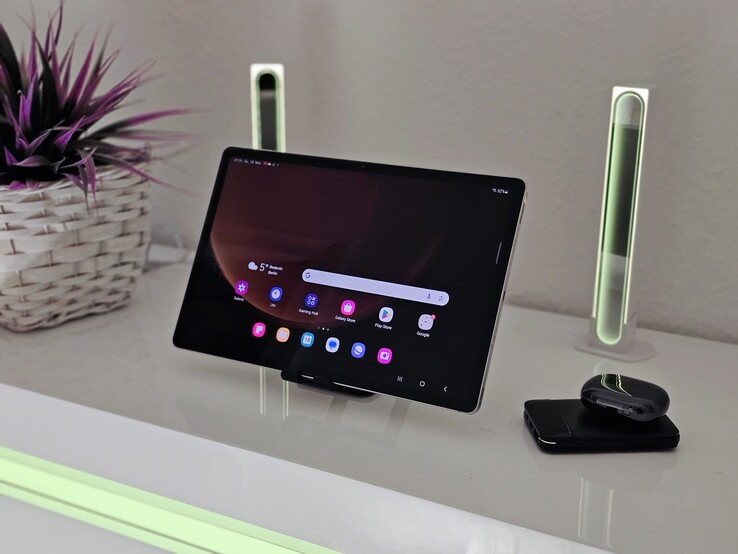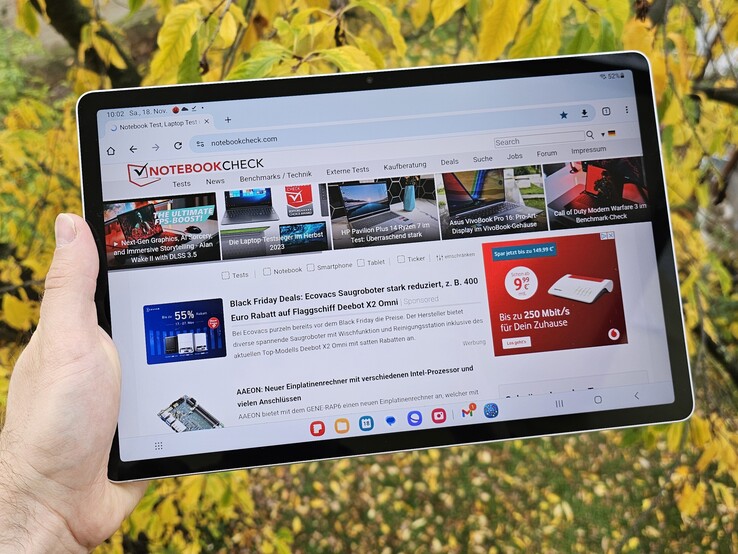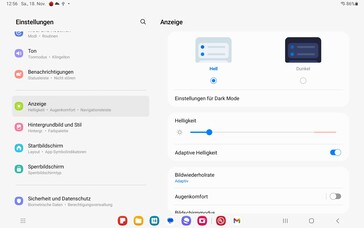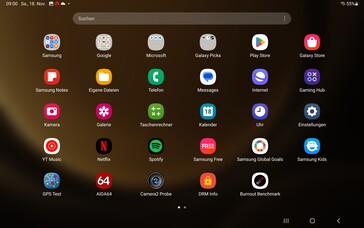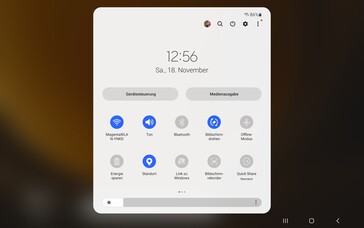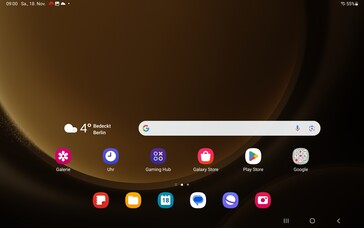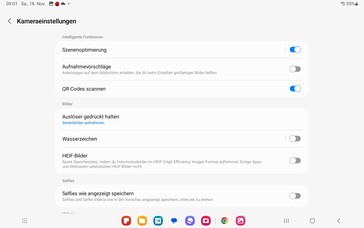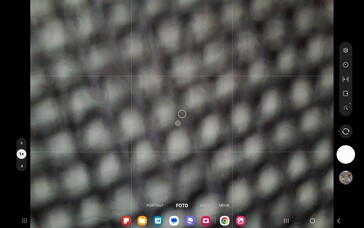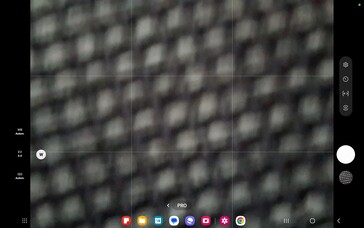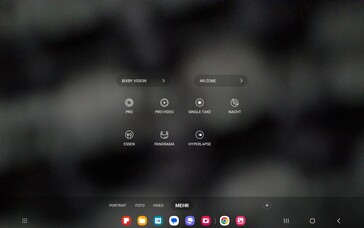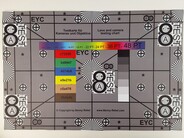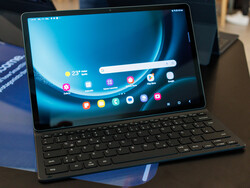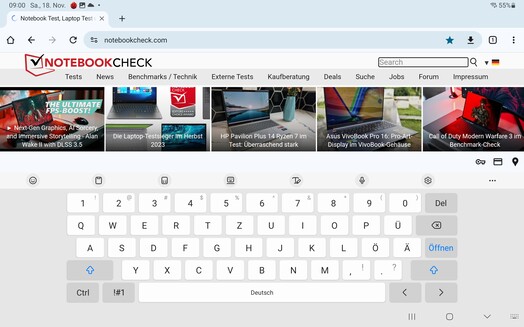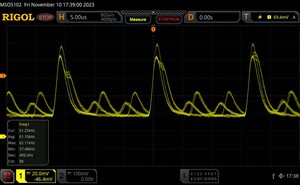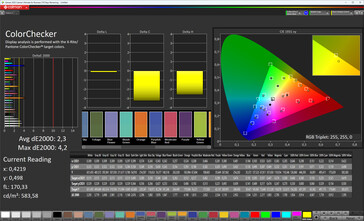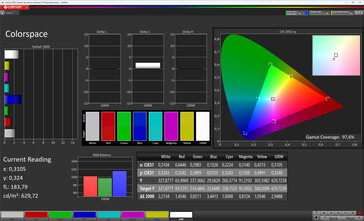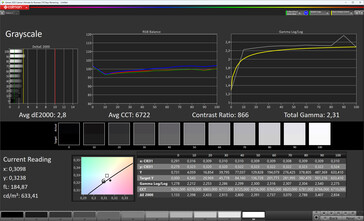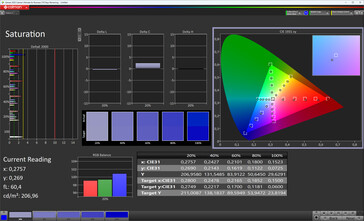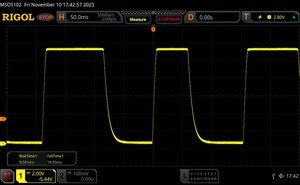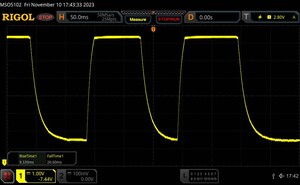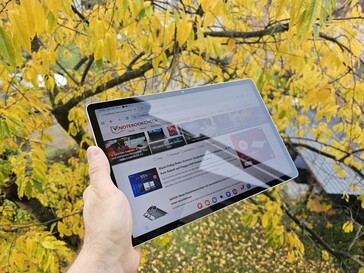Samsung Galaxy Tab S9 FE+ (Plus) in review - Waterproof XXL tablet with S Pen and a bright display
After a two-year wait, Samsung has unveiled the successor to the Galaxy Tab S7 FE, introducing the new Galaxy Tab S9 FE+. This 'Fan Edition' remains a more affordable alternative to the Galaxy Tab S9 Plus, foregoing an AMOLED display and opting for the comparatively less powerful Exynos 1380 instead of the Qualcomm Snapdragon 8 Gen 2 found in its larger counterpart. The 12.4-inch TFT panel now boasts a faster 90 Hz refresh rate, and the optional 5G version supports eSIM functionality.
The latter is available with an RRP starting at ~US$549 for 128 GB of memory and 8 GB of RAM. The top-tier version (12 GB, 256 GB) can be purchased for ~US$649.
Potential Competitors in Comparison
Rating | Date | Model | Weight | Height | Size | Resolution | Best Price |
|---|---|---|---|---|---|---|---|
| 87 % | 11/2023 | Samsung Galaxy Tab S9 FE Plus Exynos 1380, Mali-G68 MP5 | 627 g | 6.5 mm | 12.40" | 2560x1600 | |
| 85.8 % | 08/2021 | Samsung Galaxy Tab S7 FE 5G SD 750G 5G, Adreno 619 | 608 g | 6.3 mm | 12.40" | 2560x1600 | |
| 91.3 % | 10/2023 | Samsung Galaxy Tab S9+ SD 8 Gen 2 for Galaxy, Adreno 740 | 586 g | 5.7 mm | 12.40" | 2800x1752 | |
| 83.3 % | 09/2023 | Amazon Fire Max 11 MT8188J, Mali-G57 MP2 | 490 g | 7.5 mm | 11.00" | 2000x1200 | |
| 85.2 % | 09/2023 | Lenovo Tab P12 Dimensity 7050, Mali-G68 MP4 | 615 g | 6.9 mm | 12.70" | 2944x1840 |
Case - Galaxy Tab S9 FE+ with IP rating
The Galaxy Tab S9 FE+ looks almost identical to the Galaxy Tab S9+; the less expensive Samsung device even has IP68 certification, which is uncommon in this price range. The Galaxy Tab S9 FE+, on the other hand, weighs 627 grams more.
The build quality of the FE version is excellent and on par with the Galaxy Tab S series. The metal case, made of an aluminum alloy, comes in four color options and exudes high quality.
Connectivity - Samsung Tablet with USB 2.0
The 128 GB UFS 3.1 memory in our test sample offers a capacity of 105 GB, accounting for the operating system and some pre-installed apps. The built-in USB 2.0 port supports the connection of storage media via USB OTG. Compared to the Galaxy Tab 9+, data transfer is notably slow, and the port cannot be used for transmitting image signals to external monitors. An M.2 SSD hard disk can only be used with an external power supply. The Galaxy tablet supports the exFAT file system (read/write) as well as NTFS (read), which is preferred by Microsoft systems.
Additional features of the Galaxy Tab S9 FE+ include the compatible S Pen, stereo speakers, and Bluetooth 5.3. Wireless transmission is facilitated by Miracast.
microSD card reader
The card slot of the Tab S9 FE+ 5G version accommodates a microSD card on one side and a nano-SIM on the other. With support for the exFAT file system, larger data content can also be stored. In combination with our reference card (AV PRO V60), the Samsung tablet demonstrates commendable microSD performance in the cross-platform disk test, with copying speeds also reaching a very good level.
| SD Card Reader - average JPG Copy Test (av. of 3 runs) | |
| Samsung Galaxy Tab S9 FE Plus (Angelbird AV Pro V60) | |
| Samsung Galaxy Tab S9+ (Angelbird V60) | |
| Samsung Galaxy Tab S7 FE 5G (Toshiba Exceria Pro M501) | |
| Lenovo Tab P12 (Angelbird AV Pro V60) | |
| Amazon Fire Max 11 (Angelbird AV Pro V60) | |
Cross Platform Disk Test (CPDT)
Software - Galaxy Tab S9 FE+ with long-term support
Samsung pairs the Android system with its proprietary One UI user interface in version 5.1. As of the testing period, the user interface of the Galaxy Tab S9 FE+ is built on Android 13, featuring security updates from August 2023. Samsung pledges four major Android updates and an exceptional five years of security patches—a rarity for tablets in the upper mid-range.
Communication and GNSS - Samsung Tablet with WiFi 6
The standard Wi-Fi 6 is supported by the Samsung tablet when connected to the home Wi-Fi network. It delivers typical transfer speeds of over 800 MBit/s when used in combination with our reference router, the Asus ROG Rapture GT-AXE11000. Choosing the 5G option of the Galaxy Tab S9 FE+ provides extra perks such as access to several frequency bands for mobile internet and eSIM functionality. It also comes with a GNSS module for tracking. During the test, our WiFi-only version was unable to connect to satellite networks, despite the fact that it should feature a GNSS module for locating (according to the company).
| Networking | |
| Samsung Galaxy Tab S9 FE Plus | |
| iperf3 receive AXE11000 |
|
| iperf3 transmit AXE11000 |
|
| Samsung Galaxy Tab S7 FE 5G | |
| iperf3 transmit AX12 |
|
| iperf3 receive AX12 |
|
| Samsung Galaxy Tab S9+ | |
| iperf3 transmit AXE11000 6GHz |
|
| iperf3 receive AXE11000 6GHz |
|
| Amazon Fire Max 11 | |
| iperf3 receive AXE11000 |
|
| iperf3 transmit AXE11000 |
|
| Lenovo Tab P12 | |
| iperf3 receive AXE11000 |
|
| iperf3 transmit AXE11000 |
|
Cameras - Galaxy Tab S9 FE+ with dual camera
The 12 MP camera embedded into the frame above the display features an f/2.4 aperture and delivers decent results in ample light conditions. Interestingly, the front lens is capable of recording videos in UHD quality, whereas the main camera on the back is limited to a maximum of FHD.
The dual-cam solution on the rear, both with a resolution of 8 MP, is well-suited for capturing images of documents but falls short for more complex pictures. Although HDR is employed in image processing, the dynamic range of wide-angle and ultra-wide-angle photos could be significantly improved, lacking in detail. However, our analysis of color reproduction does not reveal any major points of criticism, and the built-in autofocus functions reliably—a feature not universally offered by tablets in this price range.
Image Comparison
Choose a scene and navigate within the first image. One click changes the position on touchscreens. One click on the zoomed-in image opens the original in a new window. The first image shows the scaled photograph of the test device.
WeitwinkelWeitwinkelLow LightUltraweitwinkelZoom 5x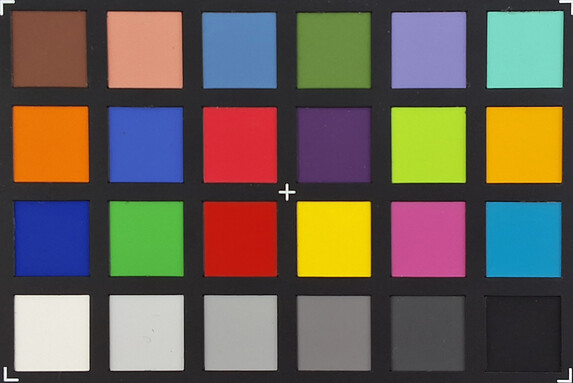

Accessories and warranty - Samsung Galaxy Tab S9 FE+ without the power adapter
When unpacking the tablet, the slim box suggests that the Samsung Galaxy Tab S9 FE+ does not include a power adapter. Aside from a USB cable and the S Pen, the delivery box contains only informational materials. Samsung provides optional accessories for its mid-range tablet, including a Book Cover Keyboard Slim or an S Pen Creator Edition.
Samsung offers a 12-month warranty on its tablets.
Input devices & operation - Samsung Tablet with S Pen
Finger inputs on the 12.4-inch TFT panel are executed swiftly. Thanks to the increased frame rate of up to 90 Hz compared to its predecessor, animations are notably smooth. However, it's worth noting that a vibration motor is not installed.
The included S Pen makes handwritten notes a breeze with the Tab S9 FE+. While Samsung doesn't specify latency for either the 'normal' S Pen or the compatible S Pen Creator Edition, our experience revealed minimal delays. A practical feature is that the Samsung pen for the Tab S9 FE+ doesn't require charging. Nevertheless, certain functions present in a Galaxy Tab S9+, such as gesture control, are not available.
The fingerprint reader, integrated into the on/off button, isn't the most convenient due to its position in the upper frame of a 12.4-inch tablet. Despite this, it boasts a good recognition rate in everyday use. For biometric identification through face recognition, an unlock function is facilitated via the front camera. Unfortunately, only one user profile is supported.
Display - Galaxy Tab with TFT-Display
The TFT panel of the Galaxy Tab S9 FE+ boasts a 1,600p resolution, achieving a pixel density of 243 ppi, and refreshes at a rate of up to 90 Hz. In our brightness measurement, the Samsung tablet reaches a maximum of 790 cd/m², which is highly appealing for this price range. Surprisingly, our APL18 measurement, with a maximum of 691 cd/m², indicates lower luminosity than a full white display.
PWM-sensitive people will continue to find what they are looking for in the Galaxy Tab S Cosmos after switching from the Galaxy Tab S9 to an OLED display with the FE model, as low-frequency screen flickering cannot be measured on the Tab S9 FE+.
| |||||||||||||||||||||||||
Brightness Distribution: 92 %
Center on Battery: 789 cd/m²
Contrast: 1096:1 (Black: 0.72 cd/m²)
ΔE Color 2.3 | 0.5-29.43 Ø5
ΔE Greyscale 2.8 | 0.57-98 Ø5.3
97.6% sRGB (Calman 2D)
Gamma: 2.31
| Samsung Galaxy Tab S9 FE Plus TFT LCD, HDR10, HGL, 2560x1600, 12.40 | Samsung Galaxy Tab S7 FE 5G LCD IPS, 2560x1600, 12.40 | Samsung Galaxy Tab S9+ AMOLED, 2800x1752, 12.40 | Amazon Fire Max 11 TFT LCD, 2000x1200, 11.00 | Lenovo Tab P12 LTPS, 2944x1840, 12.70 | |
|---|---|---|---|---|---|
| Screen | 9% | -10% | -27% | -4% | |
| Brightness middle | 789 | 619 -22% | 574 -27% | 564 -29% | 435 -45% |
| Brightness | 762 | 593 -22% | 551 -28% | 509 -33% | 407 -47% |
| Brightness Distribution | 92 | 91 -1% | 89 -3% | 86 -7% | 89 -3% |
| Black Level * | 0.72 | 0.22 69% | 0.4 44% | 0.58 19% | |
| Contrast | 1096 | 2814 157% | 1410 29% | 750 -32% | |
| Colorchecker dE 2000 * | 2.3 | 2.6 -13% | 2.01 13% | 4 -74% | 1.5 35% |
| Colorchecker dE 2000 max. * | 4.2 | 6.6 -57% | 4.93 -17% | 7.1 -69% | 3.2 24% |
| Greyscale dE 2000 * | 2.8 | 4 -43% | 2.8 -0% | 5 -79% | 2.4 14% |
| Gamma | 2.31 95% | 2.17 101% | 2.066 106% | 2.07 106% | 2.2 100% |
| CCT | 6722 97% | 6973 93% | 6566 99% | 1168 557% | 6546 99% |
* ... smaller is better
Screen Flickering / PWM (Pulse-Width Modulation)
| Screen flickering / PWM detected | 61100 Hz | ≤ 14 % brightness setting | |
The display backlight flickers at 61100 Hz (worst case, e.g., utilizing PWM) Flickering detected at a brightness setting of 14 % and below. There should be no flickering or PWM above this brightness setting. The frequency of 61100 Hz is quite high, so most users sensitive to PWM should not notice any flickering. In comparison: 53 % of all tested devices do not use PWM to dim the display. If PWM was detected, an average of 17903 (minimum: 5 - maximum: 3846000) Hz was measured. | |||
Measurement series with fixed zoom level and different brightness settings
We assess the color calibration of the TFT panel using the CalMAN analysis software. Our measured DeltaE values for the sRGB color space fall within the target range (<3), making differences to the reference colors hardly noticeable. The black value of 0.72 cd/m² only yields a modest contrast ratio of around 1,000:1, which was better addressed in the previous version.
Display Response Times
| ↔ Response Time Black to White | ||
|---|---|---|
| 20.43 ms ... rise ↗ and fall ↘ combined | ↗ 5.501 ms rise | |
| ↘ 14.93 ms fall | ||
| The screen shows good response rates in our tests, but may be too slow for competitive gamers. In comparison, all tested devices range from 0.1 (minimum) to 240 (maximum) ms. » 40 % of all devices are better. This means that the measured response time is similar to the average of all tested devices (21.5 ms). | ||
| ↔ Response Time 50% Grey to 80% Grey | ||
| 35.94 ms ... rise ↗ and fall ↘ combined | ↗ 9.339 ms rise | |
| ↘ 26.6 ms fall | ||
| The screen shows slow response rates in our tests and will be unsatisfactory for gamers. In comparison, all tested devices range from 0.2 (minimum) to 636 (maximum) ms. » 44 % of all devices are better. This means that the measured response time is similar to the average of all tested devices (33.7 ms). | ||
The Tab S9 FE+ remains easily readable outdoors in winter conditions. Reflections on the Gorilla Glass 3 surface might be bothersome in midsummer. If you intend to use the 12.4-inch screen outdoors, sacrificing brightness with manual control is hardly necessary, as a maximum of 661 cd/m² is also available in this setting.
The viewing angle stability of the TFT panel is commendable, and color fidelity is consistently maintained during normal viewing.
Performance - Samsung tablet with in-house SoC
During regular usage, the Tab S9 FE+ exhibits slight lags and stutters, making it difficult to operate with confidence. While it outperforms its predecessor in our benchmark package, the built-in Exynos 1380 is not a performance powerhouse—lagging significantly behind the faster Galaxy Tab S9+.
The Mali-G68 MP5 struggles in the graphics department, and although a Lenovo Tab P12 with the Mali-G68 MP4 fares no better. Overall, the Tab S9 FE+ is not suitable for high frame rate (HFR) gaming, as revealed in our test of the Galaxy A54 5G with its lower pixel density. Application loading times are moderate, but the write rates of the UFS 2.1 memory could be higher for small data blocks.
| UL Procyon AI Inference for Android - Overall Score NNAPI | |
| Amazon Fire Max 11 | |
| Samsung Galaxy Tab S9+ | |
| Average of class Tablet (1662 - 44323, n=49, last 2 years) | |
| Samsung Galaxy Tab S7 FE 5G | |
| Samsung Galaxy Tab S9 FE Plus | |
| Average Samsung Exynos 1380 (5835 - 6152, n=5) | |
| Lenovo Tab P12 | |
GFXBench (DX / GLBenchmark) 2.7: T-Rex Onscreen | 1920x1080 T-Rex Offscreen
GFXBench 3.0: on screen Manhattan Onscreen OGL | 1920x1080 1080p Manhattan Offscreen
GFXBench 3.1: on screen Manhattan ES 3.1 Onscreen | 1920x1080 Manhattan ES 3.1 Offscreen
GFXBench: on screen Car Chase Onscreen | 1920x1080 Car Chase Offscreen | on screen Aztec Ruins High Tier Onscreen | 2560x1440 Aztec Ruins High Tier Offscreen | on screen Aztec Ruins Normal Tier Onscreen | 1920x1080 Aztec Ruins Normal Tier Offscreen | 3840x2160 4K Aztec Ruins High Tier Offscreen
| 3DMark / Wild Life Extreme Unlimited | |
| Samsung Galaxy Tab S9+ | |
| Samsung Galaxy Tab S9 FE Plus | |
| Lenovo Tab P12 | |
| Samsung Galaxy Tab S7 FE 5G | |
| Amazon Fire Max 11 | |
| 3DMark / Wild Life Extreme | |
| Samsung Galaxy Tab S9+ | |
| Samsung Galaxy Tab S9 FE Plus | |
| Lenovo Tab P12 | |
| Samsung Galaxy Tab S7 FE 5G | |
| Amazon Fire Max 11 | |
| 3DMark / Wild Life Unlimited Score | |
| Samsung Galaxy Tab S9 FE Plus | |
| Lenovo Tab P12 | |
| Samsung Galaxy Tab S7 FE 5G | |
| Amazon Fire Max 11 | |
| 3DMark / Wild Life Score | |
| Samsung Galaxy Tab S9 FE Plus | |
| Lenovo Tab P12 | |
| Samsung Galaxy Tab S7 FE 5G | |
| Amazon Fire Max 11 | |
| 3DMark / Sling Shot Extreme (ES 3.1) Unlimited | |
| Samsung Galaxy Tab S9 FE Plus | |
| Lenovo Tab P12 | |
| Samsung Galaxy Tab S7 FE 5G | |
| Amazon Fire Max 11 | |
| 3DMark / Sling Shot Extreme (ES 3.1) Unlimited Graphics | |
| Samsung Galaxy Tab S9 FE Plus | |
| Lenovo Tab P12 | |
| Samsung Galaxy Tab S7 FE 5G | |
| Amazon Fire Max 11 | |
| 3DMark / Sling Shot Extreme (ES 3.1) Unlimited Physics | |
| Samsung Galaxy Tab S9 FE Plus | |
| Lenovo Tab P12 | |
| Amazon Fire Max 11 | |
| Samsung Galaxy Tab S7 FE 5G | |
| GFXBench (DX / GLBenchmark) 2.7 / T-Rex Onscreen | |
| Samsung Galaxy Tab S9+ | |
| Samsung Galaxy Tab S9 FE Plus | |
| Amazon Fire Max 11 | |
| Lenovo Tab P12 | |
| Samsung Galaxy Tab S7 FE 5G | |
| GFXBench (DX / GLBenchmark) 2.7 / T-Rex Offscreen | |
| Samsung Galaxy Tab S9+ | |
| Samsung Galaxy Tab S9 FE Plus | |
| Lenovo Tab P12 | |
| Samsung Galaxy Tab S7 FE 5G | |
| Amazon Fire Max 11 | |
| GFXBench 3.0 / Manhattan Onscreen OGL | |
| Samsung Galaxy Tab S9+ | |
| Samsung Galaxy Tab S9 FE Plus | |
| Amazon Fire Max 11 | |
| Lenovo Tab P12 | |
| Samsung Galaxy Tab S7 FE 5G | |
| GFXBench 3.0 / 1080p Manhattan Offscreen | |
| Samsung Galaxy Tab S9+ | |
| Samsung Galaxy Tab S9 FE Plus | |
| Lenovo Tab P12 | |
| Samsung Galaxy Tab S7 FE 5G | |
| Amazon Fire Max 11 | |
| GFXBench 3.1 / Manhattan ES 3.1 Onscreen | |
| Samsung Galaxy Tab S9+ | |
| Samsung Galaxy Tab S9 FE Plus | |
| Amazon Fire Max 11 | |
| Samsung Galaxy Tab S7 FE 5G | |
| Lenovo Tab P12 | |
| GFXBench 3.1 / Manhattan ES 3.1 Offscreen | |
| Samsung Galaxy Tab S9+ | |
| Samsung Galaxy Tab S9 FE Plus | |
| Lenovo Tab P12 | |
| Samsung Galaxy Tab S7 FE 5G | |
| Amazon Fire Max 11 | |
| GFXBench / Car Chase Onscreen | |
| Samsung Galaxy Tab S9+ | |
| Samsung Galaxy Tab S9 FE Plus | |
| Amazon Fire Max 11 | |
| Lenovo Tab P12 | |
| Samsung Galaxy Tab S7 FE 5G | |
| GFXBench / Car Chase Offscreen | |
| Samsung Galaxy Tab S9+ | |
| Samsung Galaxy Tab S9 FE Plus | |
| Lenovo Tab P12 | |
| Samsung Galaxy Tab S7 FE 5G | |
| Amazon Fire Max 11 | |
| GFXBench / Aztec Ruins High Tier Onscreen | |
| Samsung Galaxy Tab S9+ | |
| Samsung Galaxy Tab S9 FE Plus | |
| Amazon Fire Max 11 | |
| Lenovo Tab P12 | |
| Samsung Galaxy Tab S7 FE 5G | |
| GFXBench / Aztec Ruins High Tier Offscreen | |
| Samsung Galaxy Tab S9+ | |
| Samsung Galaxy Tab S9 FE Plus | |
| Lenovo Tab P12 | |
| Samsung Galaxy Tab S7 FE 5G | |
| Amazon Fire Max 11 | |
| GFXBench / Aztec Ruins Normal Tier Onscreen | |
| Samsung Galaxy Tab S9+ | |
| Samsung Galaxy Tab S9 FE Plus | |
| Amazon Fire Max 11 | |
| Lenovo Tab P12 | |
| Samsung Galaxy Tab S7 FE 5G | |
| GFXBench / Aztec Ruins Normal Tier Offscreen | |
| Samsung Galaxy Tab S9+ | |
| Samsung Galaxy Tab S9 FE Plus | |
| Lenovo Tab P12 | |
| Samsung Galaxy Tab S7 FE 5G | |
| Amazon Fire Max 11 | |
| GFXBench / 4K Aztec Ruins High Tier Offscreen | |
| Samsung Galaxy Tab S9+ | |
| Samsung Galaxy Tab S9 FE Plus | |
| Lenovo Tab P12 | |
| Amazon Fire Max 11 | |
| Jetstream 2 - Total Score | |
| Samsung Galaxy Tab S9+ (Chrome 117) | |
| Average Samsung Exynos 1380 (94.6 - 119.6, n=5) | |
| Samsung Galaxy Tab S9 FE Plus (Chrome 118) | |
| Average of class Tablet (19.9 - 236, n=59, last 2 years) | |
| Lenovo Tab P12 (Chrome 115.0.5790.166) | |
| Amazon Fire Max 11 (Chrome 116.0.5845.114) | |
| Samsung Galaxy Tab S7 FE 5G (Chrome91) | |
| WebXPRT 4 - Overall | |
| Samsung Galaxy Tab S9+ (Chrome 117) | |
| Average Samsung Exynos 1380 (97 - 123, n=5) | |
| Samsung Galaxy Tab S9 FE Plus (Chrome 118) | |
| Average of class Tablet (21 - 227, n=57, last 2 years) | |
| Lenovo Tab P12 (Chrome 115.0.5790.166) | |
| Amazon Fire Max 11 (Chrome 116.0.5845.114) | |
| WebXPRT 3 - Overall | |
| Samsung Galaxy Tab S9+ (Chrome 117) | |
| Average Samsung Exynos 1380 (124 - 145, n=3) | |
| Amazon Fire Max 11 (Chrome 116.0.5845.114) | |
| Average of class Tablet (34 - 342, n=42, last 2 years) | |
| Lenovo Tab P12 (Chrome 115.0.5790.166) | |
| Samsung Galaxy Tab S7 FE 5G (Chrome91) | |
| Speedometer 2.0 - Result | |
| Samsung Galaxy Tab S9+ (Chrome 117) | |
| Average Samsung Exynos 1380 (70.5 - 104, n=4) | |
| Lenovo Tab P12 (Chrome 115.0.5790.166) | |
| Average of class Tablet (14.7 - 376, n=52, last 2 years) | |
| Amazon Fire Max 11 (Chrome 116.0.5845.114) | |
| Samsung Galaxy Tab S7 FE 5G (Chrome91) | |
| Octane V2 - Total Score | |
| Samsung Galaxy Tab S9+ (Chrome 117) | |
| Average Samsung Exynos 1380 (33801 - 36155, n=5) | |
| Samsung Galaxy Tab S9 FE Plus (Chrome 118) | |
| Lenovo Tab P12 (Chrome 115.0.5790.166) | |
| Amazon Fire Max 11 (Chrome 116.0.5845.114) | |
| Average of class Tablet (2672 - 74614, n=72, last 2 years) | |
| Samsung Galaxy Tab S7 FE 5G (Chrome91) | |
| Mozilla Kraken 1.1 - Total | |
| Average of class Tablet (451 - 34733, n=59, last 2 years) | |
| Samsung Galaxy Tab S7 FE 5G (Chrome91) | |
| Amazon Fire Max 11 (Chrome 116.0.5845.114) | |
| Lenovo Tab P12 (Chrome 115.0.5790.166) | |
| Samsung Galaxy Tab S9 FE Plus (Chrome 118) | |
| Average Samsung Exynos 1380 (1099 - 1209, n=5) | |
| Samsung Galaxy Tab S9+ (Chrome 117) | |
* ... smaller is better
| Samsung Galaxy Tab S9 FE Plus | Samsung Galaxy Tab S7 FE 5G | Samsung Galaxy Tab S9+ | Amazon Fire Max 11 | Lenovo Tab P12 | Average 128 GB UFS 2.1 Flash | Average of class Tablet | |
|---|---|---|---|---|---|---|---|
| AndroBench 3-5 | 74% | 424% | -66% | 136% | 30% | 67% | |
| Sequential Read 256KB | 537.33 | 861 60% | 3413.8 535% | 299.4 -44% | 956.07 78% | 760 ? 41% | 850 ? 58% |
| Sequential Write 256KB | 245.73 | 512 108% | 2528.2 929% | 78.21 -68% | 776.24 216% | 297 ? 21% | 532 ? 116% |
| Random Read 4KB | 228.19 | 192 -16% | 450.3 97% | 81.85 -64% | 241.23 6% | 152.9 ? -33% | 167 ? -27% |
| Random Write 4KB | 68.58 | 167.5 144% | 161.3 135% | 8.23 -88% | 234.58 242% | 131.6 ? 92% | 150.8 ? 120% |
Emissions - Galaxy Tab S9 FE+ stays cool
Temperature
The casing of the Samsung tablet does not exhibit noticeable heating, whether in idle mode or under load. Additionally, we did not observe a reduction in performance during the 3DMark stress tests, indicating that the Exynos chipset can maintain a consistent level of performance.
(+) The maximum temperature on the upper side is 39.9 °C / 104 F, compared to the average of 33.8 °C / 93 F, ranging from 20.7 to 53.2 °C for the class Tablet.
(±) The bottom heats up to a maximum of 40.3 °C / 105 F, compared to the average of 33.3 °C / 92 F
(+) In idle usage, the average temperature for the upper side is 24.7 °C / 76 F, compared to the device average of 30 °C / 86 F.
3DMark Wild Life Stress Test
| 3DMark | |
| Wild Life Extreme Stress Test | |
| Lenovo Tab P12 | |
| Samsung Galaxy Tab S9 FE Plus | |
| Samsung Galaxy Tab S7 FE 5G | |
| Amazon Fire Max 11 | |
| Samsung Galaxy Tab S9+ | |
| Wild Life Stress Test Stability | |
| Lenovo Tab P12 | |
| Samsung Galaxy Tab S7 FE 5G | |
| Amazon Fire Max 11 | |
| Samsung Galaxy Tab S9 FE Plus | |
| Samsung Galaxy Tab S9+ | |
| Solar Bay Stress Test Stability | |
| Samsung Galaxy Tab S9+ | |
Speakers
The Tab S9 FE+ uses two speakers with a maximum volume exceeding 86 dB. Our measurement for the Samsung tablet reveals a linear frequency curve for the mids, although the high tones show a significant breakdown in the pink noise. While bass tones are present in the sound, they are not particularly noticeable.
Samsung Galaxy Tab S9 FE Plus audio analysis
(+) | speakers can play relatively loud (85.9 dB)
Bass 100 - 315 Hz
(±) | reduced bass - on average 13.6% lower than median
(±) | linearity of bass is average (8.1% delta to prev. frequency)
Mids 400 - 2000 Hz
(+) | balanced mids - only 3.3% away from median
(+) | mids are linear (4.2% delta to prev. frequency)
Highs 2 - 16 kHz
(+) | balanced highs - only 3.3% away from median
(+) | highs are linear (3.6% delta to prev. frequency)
Overall 100 - 16.000 Hz
(+) | overall sound is linear (12.6% difference to median)
Compared to same class
» 14% of all tested devices in this class were better, 4% similar, 83% worse
» The best had a delta of 7%, average was 23%, worst was 129%
Compared to all devices tested
» 9% of all tested devices were better, 2% similar, 89% worse
» The best had a delta of 4%, average was 25%, worst was 134%
Lenovo Tab P12 audio analysis
(+) | speakers can play relatively loud (85.8 dB)
Bass 100 - 315 Hz
(±) | reduced bass - on average 11% lower than median
(±) | linearity of bass is average (13.3% delta to prev. frequency)
Mids 400 - 2000 Hz
(±) | higher mids - on average 6% higher than median
(+) | mids are linear (5.4% delta to prev. frequency)
Highs 2 - 16 kHz
(+) | balanced highs - only 3.6% away from median
(±) | linearity of highs is average (7.2% delta to prev. frequency)
Overall 100 - 16.000 Hz
(+) | overall sound is linear (13.6% difference to median)
Compared to same class
» 18% of all tested devices in this class were better, 3% similar, 79% worse
» The best had a delta of 7%, average was 23%, worst was 129%
Compared to all devices tested
» 11% of all tested devices were better, 3% similar, 85% worse
» The best had a delta of 4%, average was 25%, worst was 134%
Energy Management - Samsung tablet with high power consumption
Power Consumption
In terms of power consumption, the Samsung tablet is economical during idle periods. However, the 15 watts measured under peak load conditions (with the burnout benchmark) are relatively high. Using a suitable power bank (PD 3.0, 100 watts), the 1,080 mAh battery of the Tab S9 FE+ can be fully recharged in approximately 150 minutes. According to the manufacturer, a maximum of 32 watts is possible.
| Off / Standby | |
| Idle | |
| Load |
|
| Samsung Galaxy Tab S9 FE Plus 10090 mAh | Samsung Galaxy Tab S7 FE 5G 10090 mAh | Samsung Galaxy Tab S9+ 10090 mAh | Amazon Fire Max 11 7500 mAh | Lenovo Tab P12 10200 mAh | |
|---|---|---|---|---|---|
| Power Consumption | 15% | -12% | 31% | -17% | |
| Idle Minimum * | 1.37 | 1.06 23% | 3.4 -148% | 1.04 24% | 1.91 -39% |
| Idle Average * | 5.37 | 6.25 -16% | 3.6 33% | 4.25 21% | 7.94 -48% |
| Idle Maximum * | 5.44 | 6.3 -16% | 3.9 28% | 4.3 21% | 8.12 -49% |
| Load Average * | 15.75 | 8.76 44% | 11.7 26% | 7.62 52% | 10.68 32% |
| Load Maximum * | 15.89 | 9.54 40% | 15.8 1% | 9.69 39% | 12.69 20% |
* ... smaller is better
Power Consumption: Geekbench (150 cd/m²)
Power Consumption: GFXBench (150 cd/m²)
Battery Life
The Galaxy tablet's runtimes are highly satisfactory in the practical Wi-Fi test with an adjusted display brightness of 150 cd/m². We achieved around 16 hours before the Tab S9 FE+ stopped working.
Pros
Cons
Verdict on the Samsung Galaxy Tab S9 FE+
The Galaxy Tab S9 FE+ is positioned in the upper mid-range and undeniably has a place in the tablet segment, thanks to its IP certification, excellent S Pen, and the assurance of long-term updates. However, whether users will still enjoy the 12.4-inch Tab S9 FE+ with the integrated Exynos 1380 at the end of software support in 2028 is, at least, open to question. After all, the relatively underpowered in-house chipset is not precisely the flagship of Samsung's tablet lineup, even if the mid-range competition, such as the Lenovo Tab P12, is not notably more powerful.
Samsung enhances its FE model in many aspects and presents an alternative to OLED competitors by eliminating PWM flickering.
With the Tab S9 FE+, large tablet enthusiasts receive an overall competitive device. For those unafraid of importing, the Xiaomi Pad 6 Max emerges as an intriguing alternative, featuring a Snapdragon 8+ Gen 1 and a 14-inch display in the price range of around ~US$600.
Price & Availability
The Samsung Galaxy Tab S9 FE+ is available for ~US$649 at Amazon.
Samsung Galaxy Tab S9 FE Plus
-
11/22/2023 v7
Marcus Herbrich
Transparency
The present review sample was made available to the author as a loan by the manufacturer or a shop for the purposes of review. The lender had no influence on this review, nor did the manufacturer receive a copy of this review before publication. There was no obligation to publish this review.


 Deutsch
Deutsch English
English Español
Español Français
Français Italiano
Italiano Nederlands
Nederlands Polski
Polski Português
Português Русский
Русский Türkçe
Türkçe Svenska
Svenska Chinese
Chinese Magyar
Magyar